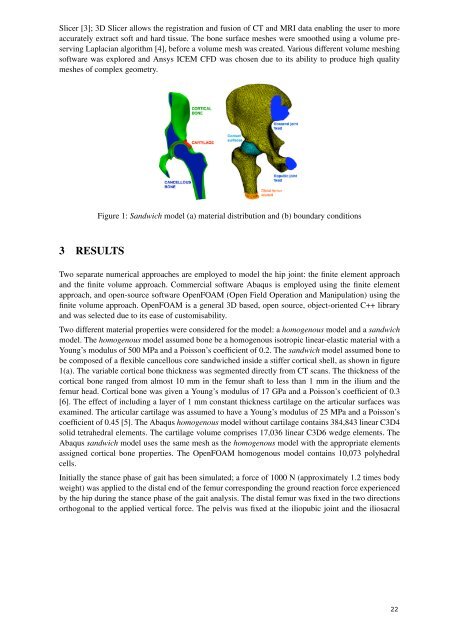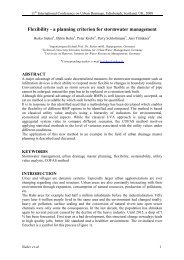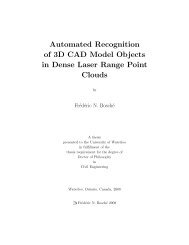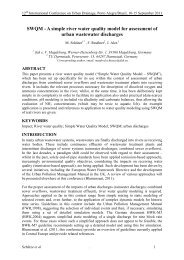ACME 2011 Proceedings of the 19 UK National Conference of the ...
ACME 2011 Proceedings of the 19 UK National Conference of the ...
ACME 2011 Proceedings of the 19 UK National Conference of the ...
You also want an ePaper? Increase the reach of your titles
YUMPU automatically turns print PDFs into web optimized ePapers that Google loves.
Slicer [3]; 3D Slicer allows <strong>the</strong> registration and fusion <strong>of</strong> CT and MRI data enabling <strong>the</strong> user to more<br />
accurately extract s<strong>of</strong>t and hard tissue. The bone surface meshes were smoo<strong>the</strong>d using a volume preserving<br />
Laplacian algorithm [4], before a volume mesh was created. Various different volume meshing<br />
s<strong>of</strong>tware was explored and Ansys ICEM CFD was chosen due to its ability to produce high quality<br />
meshes <strong>of</strong> complex geometry.<br />
3 RESULTS<br />
Figure 1: Sandwich model (a) material distribution and (b) boundary conditions<br />
Two separate numerical approaches are employed to model <strong>the</strong> hip joint: <strong>the</strong> finite element approach<br />
and <strong>the</strong> finite volume approach. Commercial s<strong>of</strong>tware Abaqus is employed using <strong>the</strong> finite element<br />
approach, and open-source s<strong>of</strong>tware OpenFOAM (Open Field Operation and Manipulation) using <strong>the</strong><br />
finite volume approach. OpenFOAM is a general 3D based, open source, object-oriented C++ library<br />
and was selected due to its ease <strong>of</strong> customisability.<br />
Two different material properties were considered for <strong>the</strong> model: a homogenous model and a sandwich<br />
model. The homogenous model assumed bone be a homogenous isotropic linear-elastic material with a<br />
Young’s modulus <strong>of</strong> 500 MPa and a Poisson’s coefficient <strong>of</strong> 0.2. The sandwich model assumed bone to<br />
be composed <strong>of</strong> a flexible cancellous core sandwiched inside a stiffer cortical shell, as shown in figure<br />
1(a). The variable cortical bone thickness was segmented directly from CT scans. The thickness <strong>of</strong> <strong>the</strong><br />
cortical bone ranged from almost 10 mm in <strong>the</strong> femur shaft to less than 1 mm in <strong>the</strong> ilium and <strong>the</strong><br />
femur head. Cortical bone was given a Young’s modulus <strong>of</strong> 17 GPa and a Poisson’s coefficient <strong>of</strong> 0.3<br />
[6]. The effect <strong>of</strong> including a layer <strong>of</strong> 1 mm constant thickness cartilage on <strong>the</strong> articular surfaces was<br />
examined. The articular cartilage was assumed to have a Young’s modulus <strong>of</strong> 25 MPa and a Poisson’s<br />
coefficient <strong>of</strong> 0.45 [5]. The Abaqus homogenous model without cartilage contains 384,843 linear C3D4<br />
solid tetrahedral elements. The cartilage volume comprises 17,036 linear C3D6 wedge elements. The<br />
Abaqus sandwich model uses <strong>the</strong> same mesh as <strong>the</strong> homogenous model with <strong>the</strong> appropriate elements<br />
assigned cortical bone properties. The OpenFOAM homogenous model contains 10,073 polyhedral<br />
cells.<br />
Initially <strong>the</strong> stance phase <strong>of</strong> gait has been simulated; a force <strong>of</strong> 1000 N (approximately 1.2 times body<br />
weight) was applied to <strong>the</strong> distal end <strong>of</strong> <strong>the</strong> femur corresponding <strong>the</strong> ground reaction force experienced<br />
by <strong>the</strong> hip during <strong>the</strong> stance phase <strong>of</strong> <strong>the</strong> gait analysis. The distal femur was fixed in <strong>the</strong> two directions<br />
orthogonal to <strong>the</strong> applied vertical force. The pelvis was fixed at <strong>the</strong> iliopubic joint and <strong>the</strong> iliosacral<br />
22













